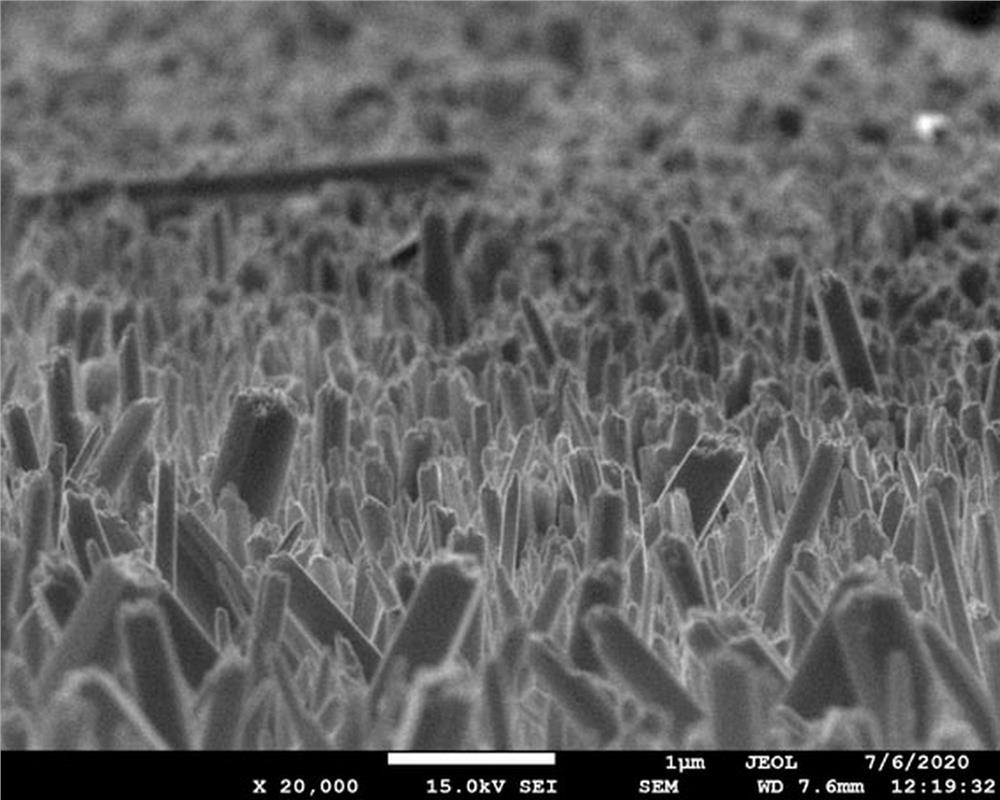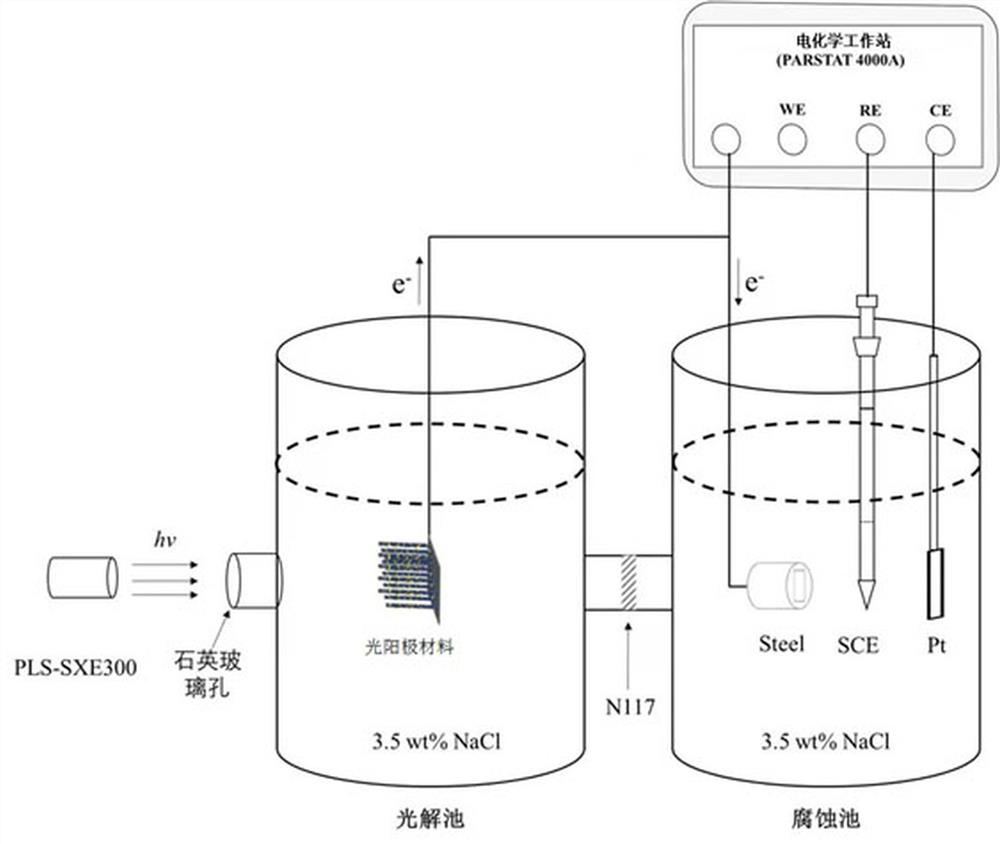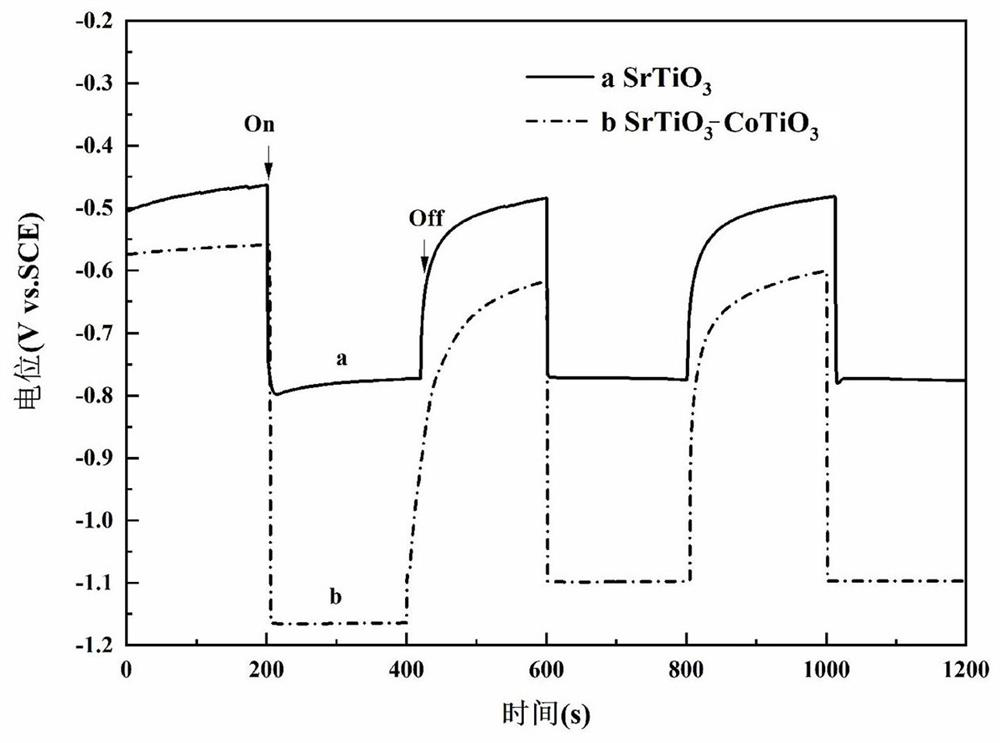Photo-anode film and preparation method and application thereof
A photoanode and hydrothermal reaction technology, which is applied in metal material coating process, coating, liquid chemical plating, etc., can solve the problems of poor metal anti-corrosion effect, improve durability, improve anti-corrosion effect, and expand light absorption The effect of utilization efficiency
- Summary
- Abstract
- Description
- Claims
- Application Information
AI Technical Summary
Problems solved by technology
Method used
Image
Examples
preparation example Construction
[0043] The present invention also provides a SrTiO 3 -CoTiO 3 A method for preparing a photoanode film, which adopts the following technical scheme: including the following steps: (1) pretreating the conductive glass; (2) placing the conductive surface of the conductive glass obtained after the pretreatment in step (1) downward In a mixed solution containing strontium salt, cobalt salt and tetrabutyl titanate, hydrothermal reaction, the surface is deposited with SrTiO 3 -CoTiO 3 Conductive glass; (3) calcining the product obtained through step (2) to obtain the SrTiO 3 -CoTiO 3 Photoanodic film.
[0044] The present invention also provides the above-mentioned SrTiO 3 -CoTiO 3 The application of the photoanode film adopts the following technical scheme: the above-mentioned SrTiO 3 -CoTiO 3 Application of photoanodic film in anticorrosion of steel reinforcement in marine construction engineering.
Embodiment 1
[0047] 1. The SrTiO of this embodiment 3 -CoTiO 3 The photoanode film is prepared according to the following method, comprising the following steps:
[0048] (1) Pretreatment of the conductive glass: Put the FTO conductive glass into the beakers of aqueous solution containing detergent, ethanol solution of NaOH, ethanol and deionized water in sequence, and ultrasonically clean them for 15 minutes respectively, and clean them up (in hydrothermal reaction Before, the FTO conductive glass needs to be thoroughly cleaned, the purpose is to improve the adhesion between the film and the glass);
[0049] (2) Add strontium nitrate, cobalt nitrate and tetrabutyl titanate into the water, stir evenly, then add N-polyvinylpyrrolidone (PVP), continue stirring until dissolved, and prepare a solution containing 0.05mmolL -1 Strontium nitrate, 0.05mmolL -1 Cobalt nitrate, 0.1mmolL -1 A mixed solution of tetrabutyl titanate and 10mmol N-polyvinylpyrrolidone (PVP), and pour the above mixed...
Embodiment 2
[0058] 1. The SrTiO of this embodiment 3 -CoTiO 3 The photoanode film is prepared according to the following method, comprising the following steps:
[0059] (1) Pre-treat the conductive glass: Put the FTO conductive glass into the beaker of aqueous solution containing detergent, ethanol solution of NaOH, ethanol and deionized water in sequence, and ultrasonically clean it for 15 minutes to clean it;
[0060] (2) Add strontium acetate, cobalt acetate and tetrabutyl titanate to water, stir evenly, then add sodium lauryl sulfate, continue stirring until dissolved, and prepare a solution containing 2.0mmolL -1 Strontium acetate, 2.0mmolL -1 Cobalt acetate, 4mmolL -1 A mixed solution of tetrabutyl titanate and 16mmol sodium dodecyl sulfate, and pour the above mixed solution into the reaction kettle; then add the conductive side of the FTO conductive glass obtained through the pretreatment of step (1) to the above mixed solution , after reacting at 150°C for 12 hours, cooling,...
PUM
 Login to View More
Login to View More Abstract
Description
Claims
Application Information
 Login to View More
Login to View More - R&D
- Intellectual Property
- Life Sciences
- Materials
- Tech Scout
- Unparalleled Data Quality
- Higher Quality Content
- 60% Fewer Hallucinations
Browse by: Latest US Patents, China's latest patents, Technical Efficacy Thesaurus, Application Domain, Technology Topic, Popular Technical Reports.
© 2025 PatSnap. All rights reserved.Legal|Privacy policy|Modern Slavery Act Transparency Statement|Sitemap|About US| Contact US: help@patsnap.com



